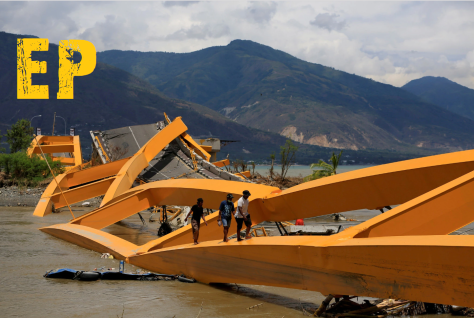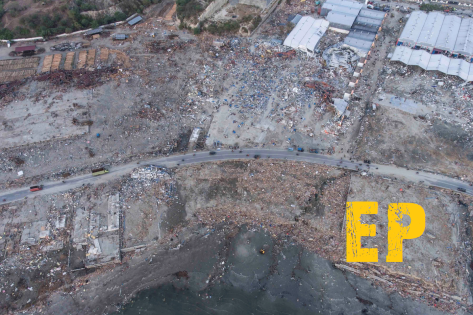
(EndTimePredictions News) Feb 7 2019 Last September, an earthquake triggered a deadly tsunami in Indonesia. Scientists now have clocked the speed of rupture at a blistering 9,600 miles per hour.
On Sept. 28, a powerful earthquake struck the Indonesian island of Sulawesi, triggering a tsunami that devastated the provincial capital, Palu. The two events together killed more than 2,200 people in the region.
Although Indonesia is one of the most seismically active countries in the world, the Palu tsunami came as a surprise to geophysicists. A tsunami occurs when a quake on the seabed abruptly pushes water upward, producing a dangerously tall wave. Usually the culprit is a megathrust earthquake, as one tectonic plate slides, or subducts, beneath another. The tsunami that hit Sumatra in 2004, causing 230,000 deaths, was generated by a megathrust quake.
In contrast, the tsunami in September was caused by what is known as a strike-slip quake. These occur at seismic faults where two tectonic plates are sliding past each other. The ground motion in such quakes is mostly horizontal — in Sulawesi, the rocks on either side of the fault lurched past each other by more than 10 feet — and rarely produce tsunamis. But the Palu earthquake caused an underwater landslide, which produced a small tsunami that grew as it swept up a narrowing bay.
And, it turns out, something even more unusual was at work, according to two papers published in the journal Nature Geoscience on Monday. As the fault ruptured, the leading edge of the rupture tore through the crust much faster than usual, perhaps magnifying the shaking that led to the underwater landslide. Such behavior has been predicted in theory, but had not been conclusively documented in nature.
Historically, seismological theories have been hard to test against actual observations. However, thanks to a growing stream of detailed data from seismometer arrays and high-resolution satellite imagery, scientists are increasingly able to compare their models to the behavior of individual earthquakes in real time.

Earthquakes are still earthquakes: vibrations caused when elastic energy stored in rocks is suddenly released. But their idiosyncrasies — the personalities of their seismic faults — are starting to show. The two recent studies offered a case in point.
An earthquake starts underground, on a tiny stretch of a fault line, when the forward pressure of one tectonic plate exceeds the force of friction holding it back. Suddenly, a slip occurs; a rip appears in the crust and quickly propagates away from its origin, much like a run in a pair of hosiery.
As the rip hurtles along, it releases elastic energy in the form of seismic waves, which ripple outward at different speeds. Pressure waves, or P-waves, are the fastest; shear waves, or S-waves, are slower but cause more ground-shaking; and last are the leisurely but devastating Rayleigh waves, which cause the ground to roll like swells on the sea.
Typically, and according to basic geophysical theory, a rupture travels no faster than the slowest seismic waves. But the new research indicated that the rupture from the Palu earthquake outran even its own S-waves, making it one of the first documented “super-shear” earthquakes.
In one paper, Anne Soquet of the Université Grenoble Alpes, in France, and three co-authors examined optical and radar imagery from Japan’s Advanced Land Observing Satellite 2, which showed millimeter-scale displacements of the Earth’s surface before and after the Sulawesi quake. The data revealed that the rupture began north of Palu, on a previously unknown fault segment, and in 30 seconds traveled at least 80 miles southward.
On average, the rupture unzipped the crust at a rate of 2.7 miles per second, or 9,600 miles per hour, almost 25 percent faster than is typical, and among the fastest ever recorded for rocks at shallow depths. This blistering pace was made possible by an unusually flat, smooth stretch of the fault south of Palu, Dr. Soquet’s team wrote. Their conclusion was consistent with theoretical models suggesting that only geometrically simple faults could transmit such ruptures.
In the second study, a team led by Han Bao of the University of California, Los Angeles, assembled a second-by-second timeline of the rupture from surface radar imagery and the dense network of seismic stations around the Indian Ocean. This team, too, observed that the rupture outran its S-waves. Much as a motorboat or supersonic jet outruns its wake, the rupture generated an expanding, V-shaped pattern of disruption, known as a Mach cone, behind it.
The team was able to calculate precisely when the different kinds of seismic waves arrived at different monitoring stations. It found that the rupture from the Palu earthquake unfolded in distinct phases, slowing at about 10 seconds and 25 seconds after the initial slip, perhaps because of bends in the fault or variations in rock friction.

Even with those impediments, the rupture traveled at super-shear velocity, and it did so right from the start. That was surprising: Current models suggest that a rupture must travel some minimum distance before hitting super-shear speeds, just as a sprinter needs a few yards to reach top speed.
Maybe, Dr. Bao and his co-authors wrote, the initial stretch of the fault zone was made up of heavily fractured and damaged rock. The rupture could have cruised right through it, without expending energy breaking up pristine rock.
Together, the two new papers offer the strongest evidence yet that seismic ruptures can reach super-shear speeds. In 2013, an aftershock of an earthquake that occurred 380 miles below the Sea of Okhotsk was inferred to have done so, but the speed and length of a rupture are hard to measure precisely at such depth.
The findings give a geophysicist much to ponder. Was the super-shear behavior intrinsic to this fault, or was it prompted by something specific in how the quake began? Are certain kinds of rock, or older and more damaged faults, more likely to produce super-shear quakes?Ultimately, how unique was this event?
The implications are humanitarian as well as scientific. Strike-slip faults can be found around the world, including in many densely inhabited areas: the San Andreas fault in California; the Anatolian fault system in Turkey; the Dead Sea fault in the Middle East; and the Enriquillo fault in Haiti. Humankind’s seismic neighbors will be around for a long time, we’d do well to get to know them.(EndTimePredictions News)
Credit’s To Source <Click Me
EndTimePredictions News #EPTheGreatAwakening
http://www.endtimepredictions.wordpress.com/
